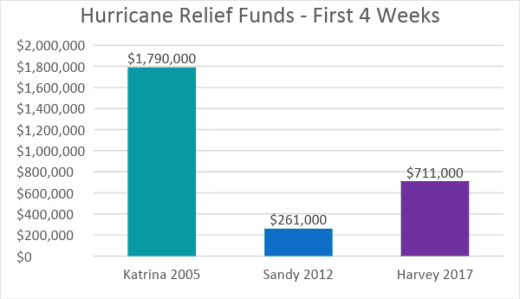
When disaster strikes, people respond. Money, aid and in-kind donations come pouring in to help the victims.
In that sense, 2017 was no different from any other year. What set it apart was the number and magnitude of the disasters—earthquakes, floods, hurricanes, wildfires and more. As these disasters unfolded in rapid succession, some interesting trends in giving emerged. Giving USA outlines these broad trends in its Giving 2018 Annual Report.
Hurricane Harvey Profile
Hurricane Harvey was the first hurricane to hit the U.S. in 2017, causing lost lives and an estimated $180 billion in damage. In the three months that followed, contributions totaled $1.07 billion. Compared to Hurricane Katrina in 2005, these funds were significantly lower, although higher than the funds raised for Hurricane Sandy in 2012. This is probably not surprising, given the fact that Hurricane Harvey was followed by so many disasters in such a short time: Hurricane Irma made landfall 15 days later and Hurricane Maria struck 10 days after that.

Community Foundations Gain Importance
In the past, giving for disaster relief has centered on human services and public-society benefit organizations. Last year there was a shift and 30.6% of disaster giving went to foundations. Community foundations played a significant role in disaster relief. In Houston, for instance, the Hurricane Harvey Relief Fund raised more than $112 million. By contrast, traditional organizations raised substantial funds but didn’t reach the same levels as with Hurricane Katrina.
Saving Animals
Another emerging trend is the growing role of animal welfare organizations in disaster response. Learning from Hurricane Katrina, there were more large-scale animal recovery efforts following disasters in 2017. Many organizations aimed to preemptively evacuate animals in the path of hurricanes and then reunite them with their owners afterward.
Online Giving and Crowdfunding on the Rise
Last year also saw a growing trend in online giving in response to disasters. In fact, many individuals now view online giving as their first choice in contributing to disaster recovery.
Crowdfunding has become an effective way to raise funds quickly for disaster relief. More than 3,600 campaigns were created on YouCaring in the six weeks following Hurricane Harvey and over 850 campaigns were created on GoFundMe. Celebrities have effectively used these platforms to raise funds for a variety of disaster recovery efforts.
GoFundMe, and its sister site CrowdRise, processed $65 million for Hurricane Harvey and $11.9 million for Las Vegas Victims to aid the victims and survivors of the Las Vegas shooting. However, some have criticized GoFundMe’s business model and the 5% user fees that resulted in the company earning $3.5 million from Hurricane Harvey relief funds. GoFundMe has since made the user fee optional for personal campaigns while keeping it mandatory for organizational users.
What’s Your Experience?
Are you involved in raising funds for disaster relief? How do these trends match up with your experience? Do you have any insights to offer on how disaster giving has evolved over the last few years? Share your thoughts in the comments below. We’d love to hear from you.
